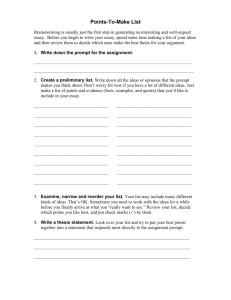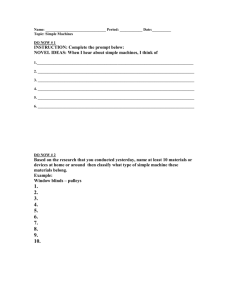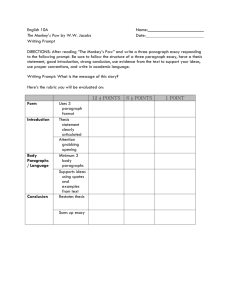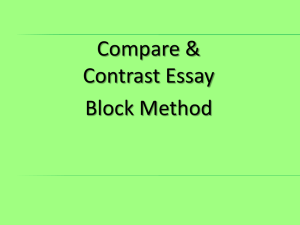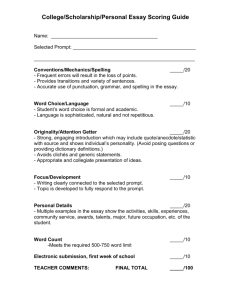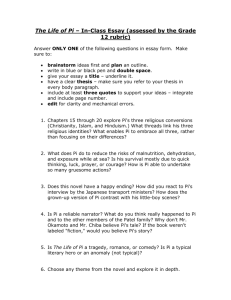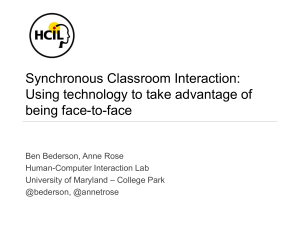Choice PPT - barrygilmore
advertisement
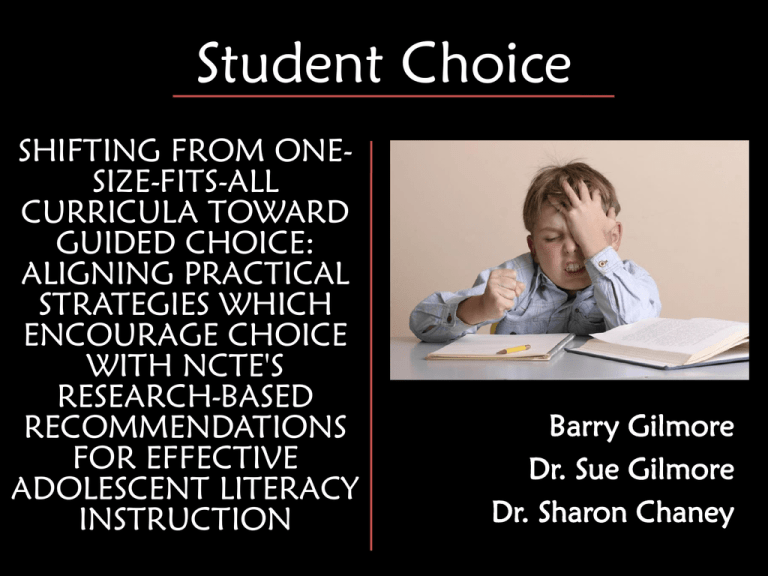
Student Choice SHIFTING FROM ONESIZE-FITS-ALL CURRICULA TOWARD GUIDED CHOICE: ALIGNING PRACTICAL STRATEGIES WHICH ENCOURAGE CHOICE WITH NCTE'S RESEARCH-BASED RECOMMENDATIONS FOR EFFECTIVE ADOLESCENT LITERACY INSTRUCTION Barry Gilmore Dr. Sue Gilmore Dr. Sharon Chaney Presentation Outline I. What choices do we offer already? II. What does the research say? III. How can we categorize choice? IV. What does choice look like in a language arts classroom? V. Questions and discussion I. What choices do we offer already? Presentation Outline The practices of do highly effective adolescent I. What choices we offer already? literacy teachers reveal a number of common qualities… II. What does the research say? #5 …using hands-on, scaffolding, minilessons, discussions, group work, student choice, ample feedback, and multiple forms of expression. The Council Chronicle, NCTE, September 2007, p. 20 II. What does the research say? “…a new study calculates the one-third of American college students have to enroll in remedial classes. The bill to colleges and taxpayers to bring them up to speed on material they were supposed to learn in high school comes to between $2.3 billion and $2.9 billion annually.” “Diploma to Nowhere,” Study by Strong American Schools, as reported by Associated Press, September, 2008. II. What does the research say? In handouts: Examples of Choice in Schools (Kohn) “higher on standardized tests” “more likely…to continue working even on relatively uninteresting tasks.” “even if our only criterion is academic performance, choice works.” II. What does the research say? Students from high schools whose “essential value was democracy” performed better in college than their peers. Kathy Irwin, "The Eight Year Study," in Jervis and Montag, eds., p. 59. II. What does the research say? We found a plethora of information about students' reading preferences in the literature classroom. However, few resources focus on teaching students how to choose in the literature classroom specifically. (ALAN review, Susan Dunn, 2003) The Value of Choice School Policy: 1. In each grade, students read two books for summer reading 2. All students read the same two books 3. Teachers may not assign other work over the summer 4. Teachers must assess reading in some way during first week of school 5. Essential reading list (with books provided to school) Distress is inversely related to how much influence and autonomy teachers say they have with respect to school policy. Elizabeth Tuettemann and Keith F. Punch, "Teachers' Psychological Distress: The Ameliorating Effects of Control over the Work Environment," Educational Review, vol. 44, 1992, pp. 181-94. The Value of Choice Your Choice: Turn your paper in on time and get full credit or turn it in late and get half credit. The Value of Choice For your summer reading, choose one of the following: 1. The Song of Roland (anon.) 2. Morte D’Arthur (Mallory) 3. Le Roman de la Rose (Christine de Pisan) The Value of Choice For your summer reading, choose two of the following: Peace Like a River Moby Dick The Things They Carried Catcher in the Rye My Antonia Age of Innocence The Bean Trees Death of a Salesman Beloved In Cold Blood Invisible Man The Sound and the Fury The Sun Also Rises The Handmaid’s Tale The Bluest Eye The Crucible Summons to Memphis The Awakening Herland Eva Luna Catch-22 Raisin in the Sun Confederacy of Dunces Fences House of Seven Gables Walden Going After Cacciato The Color Purple Sacred Hunger The Joy Luck Club All the Pretty Horses Tortilla Curtain Blood Meridian The Dispossessed Bonfire of the Vanities Caramelo The House of the Spirits Farewell to Arms The Unvanquished East of Eden The Killer Angels Our Town Presentation Outline Classroom Practicality Civic/Personal Agency When Wilhelm asked his students about the role of choice in I. What choices do responded, we offer already? the classroom, they "YouUnlimited made us think that we Limited had choices, but you were always putting stuff in front of Choice Choice II. What does the research say? that limited us." Another student responded choice was still choice. "Hey, when you go to a restaurant, you can choose a Guided Free dessert, III. How butcan only wefrom categorize the desserts choice? they have." Another Choice student joined Choice in with, "Yeah, if you could choose any dessert in the whole wide world you might never make up Group Individual your mind..." (47). Choice Voting (ALAN Review, 2003, Vol. 31, No. 1) Choice Consensus Student Choice (typical model) Choice of books (from a list) Choice of writing topics (from 2-3) Casual student input regarding deadlines Choice of elective courses (within schedule) Student Choice (possible model) Reading texts Writing topics, genres, format What we learn How we learn Activities use of class time Deadlines Why we due dates and amounts learn Rubrics How type we values, criteria, Syllabi book lists, class focus choose Presentation Outline Sample I. What choices do we offer already? assignments II. What does the A process for research say? writing III. How can we categorize choice? Studentdeveloped IV. What does choice look like in a syllabi language arts classroom? Literature and choice More Student Choices, More Student Interest Capstone Extended Essay Summative Assessment Senior Literary Thesis A Model for Choice Choice of theme Choice of literary works to explore theme Choice of adult advisor Some ancillary benefits of shifting to choice Students feel more control over assignment Students develop relationships with other adults interested in literature and writing Students explore ways to find critical material Teacher gets to read a variety of papers Teacher shows commitment to research-based learning Prompt Attention: Writing and Choice Concern: If I give students choice, they’re more likely to plagiarize Prompt Attention: Writing and Choice Brainstorm topics as a class I. What choices do we offer already? Prompt Attention: Writing and Choice Brainstorm topics as a class Choose individual topic/discuss Find and peer-check evidence Write a thesis statement Discussion Write an individual paper Investment Ownership Interest Better Product Motivation More Learning Senior Seminar (modeling choice) Week One Classes choose course topic In-class discussion Counter-Culture Literature Online discussion Romantic Group Comedy discussionand the Silver Screen Survey The Graphic Novel Teacher proposes book list Discussion/tweaking Contracting Senior Seminar (modeling choice) Week One Classes choose course topic Weeks 2-9 ReadingClass and Writing ReadingChoices Group Reading Group Essay Topics Individual Essay Thesis Statements Group Projects Senior Seminar (modeling choice) Week One Classes choose course topic Weeks 2-9 Reading and Writing Choices Weeks 10-18 Participation Choices Student-led discussion activities Individual reading choices Literature, Choice, and Civic Agency Democracy and decision-making: Lord of the Flies, One Flew Over the Cuckoo’s Nest, An Enemy of the People When democracy fails--dystopias: 1984, Brave New World, The Giver Personal choices: “The Road Not Taken,” To Kill a Mockingbird Presentation Outline Handouts and PowerPoint: I. What choices do we offer already? http://barrygilmore.wikispaces.com II. What does the research say? Books and Lesson Plans: III. How can wewww.barrygilmore.com categorize choice? IV. What does choice look like in a language arts classroom? V. Questions and discussion
